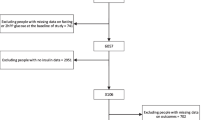Abstract
Aims/hypothesis. To evaluate insulin sensitivity and insulin secretion in prediabetic and diabetic subjects with mutations in MODY1 (HNF-4α) and MODY3 (HNF-1α) genes, in subjects with GAD antibodies, latent autoimmune diabetes in adults and in subjects with the common form of Type II (non-insulin-dependent) diabetes mellitus. Methods. Insulin secretion was measured as the incremental 30-min insulin (I30) and insulin glucose ratio (I:G30) during OGTT whereas insulin sensitivity was measured as the insulin sensitivity index during OGTT in 131 carriers of MODY mutations [NGT = 38, IFG/IGT = 21, diabetes mellitus (DM) = 72], in 293 subjects with GADA (NGT = 47, IFG/IGT = 29, DM = 217) and in 2961 subjects with a family history of the common form of Type II diabetes but without MODY mutations or GADA (NGT = 1360, IFG/IGT = 857, DM = 744). A subgroup of the subjects underwent a euglycaemic clamp (n = 210) and intravenous glucose tolerance test (n = 337) for the estimation of insulin sensitivity and first-phase insulin secretion. Results. Non-diabetic subjects with MODY mutations had pronounced impaired insulin secretion (I30, I:G30) compared with the two other groups (p = 0.005). Normal or non-diabetic glucose tolerance was maintained by enhanced insulin sensitivity compared with the other two groups (p < 0.05 and p < 0.005). In contrast to patients with Type II diabetes and with adult latent autoimmune diabetes, MODY patients showed only a modest deterioration in insulin sensitivity at onset of diabetes. The 2-h glucose values inversely correlated with insulin sensitivity in subjects with GADA (r = –0.447, p < 0.001) and subjects from Type II diabetic families (r = –0.426, p < 0.001), whereas no such relation was observed in subjects with MODY mutations (r = 0.151, p = NS). There were no statistically significant differences in insulin secretion or insulin sensitivity between subjects with GADA or subjects with a family history of Type II diabetes, either at the NGT or the IFG/IGT stage. Conclusion/interpretation. Glucose-tolerant carriers of MODY mutations are characterised by a severe impairment in insulin secretion. Enhanced insulin sensitivity is the most likely explanation for the normal glucose tolerance. Whereas subjects with positive GADA or Type II diabetes have impaired insulin sensitivity with increasing glucose concentrations, MODY mutation carriers seem to be protected from the effect of glucose toxicity. [Diabetologia (2000) 43: 1476–1483]
Article PDF
Similar content being viewed by others
Avoid common mistakes on your manuscript.
Author information
Authors and Affiliations
Additional information
Received: 23 March 2000 and in revised form: 29 August 2000
Rights and permissions
About this article
Cite this article
Tripathy, D., Carlsson, ÅL., Lehto, M. et al. Insulin secretion and insulin sensitivity in diabetic subgroups: studies in the prediabetic and diabetic state. Diabetologia 43, 1476–1483 (2000). https://doi.org/10.1007/s001250051558
Issue Date:
DOI: https://doi.org/10.1007/s001250051558




